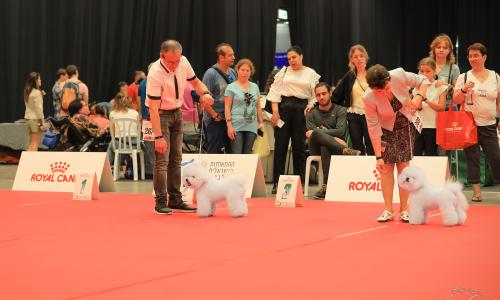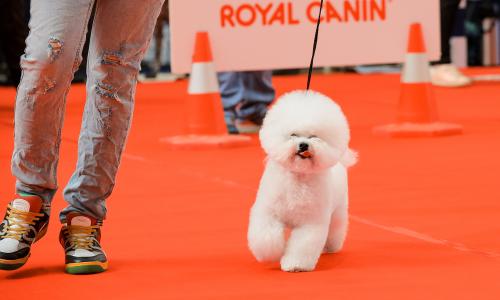Before you bring your puppy home,try to imagine what the puppy would be interested in – what he could tear, chew or pee on. Move away or hide these things of interest, though the puppy can still find something to play with or to spoil. Be ready to see a bit of a mess!
Finally, you took the puppy home. If he is scared, sitting or lying down, don't fuss around, sit beside him on the floor (perhaps with the whole family) speak in a calm manner, stroking the puppy. Once calmed down, the puppy will try to get to know his new family members, explore the atmosphere of his new house. At this point, you can offer something tasty, and then a food bowl.
Toilet
Near his mattress, and not some piece of an old carpet, a towel or a sheet. The place (mattress) should be as comfortable as possible, this way your puppy will not want to get into your bed, where he can possibly pee. All of my Bichons sleep on their mattresses or beside them.
A decent breeder teaches the puppy 'to do its thing' on a disposable underpad. Don't expect the puppy to hold it or to ask for a walk out right after the first walk. He has a short memory! After doing his thing outside, he will bring some of it home! Do not punish or praise for puddles. You can show your puppy you're upset and unhappy about his behavior, he will understand.
Help the puppy to memorize the location of his pot. If you bought him from a breeder who didn't take care of the puppy's toilet behavior, you will have to teach him yourself. Keep an eye on him and as soon as you see he's going to pee, put the undersheet beneath him and don't change it immediately to a clean one. The kid will quickly realize that this is his toilet.
The Place
If you took a grown up puppy (over 2 months old) he will adapt in the new house faster, comparing to a 1.5 month-old baby. We give away our puppies only after they are 3.5-4 months old. The puppy can follow you around the house, and when he'll get tired and fall asleep by your side, you can gently take him to his place, sit there for a while, stroke him and he will eventually get used to falling asleep in his place. If you don't mind the place to be on your bed, you need to make sure that the puppy can climb to it on his own, and most importantly - get down. When jumping off the sofa, the puppy can be seriously injured (dislocations and even fractures are the most common puppy injuries when jumping off the sofas and chairs). Remember that the puppy, thar could not get off to the floor can pee on the sofa! It's not dangerous for the puppy's health, but dangerous for the sofa.
First walks
You will need a soft nylon collar and leash (better roulette), but I strongly recommend to train and walk your puppies in a slip lead! This is a huge benefit for show dogs! Do not try to take the puppy out on his own feet – carry him out in your hands. Put him on the lawn (or snow) in a quiet place. You don't need to show the whole world around him straight away (cars, other dogs, people). It will be easier for the puppy to get used to the atmosphere in a quiet place. First, it will lie or sit in the place where you put him – just sit next to him, talking. No need to rush. The baby will sniff everything under his feet, and then, carefully standing up, will want to explore new smells. You should be next to him. The puppy should count on your help and support in case of any danger. You are his shelter, he will always try to stay at your feet. Never pull on the leash. Step back, call his name, sit down and say "Come". This will be your first lesson of obedience. If your puppy on first walks rushes at your call to your feet, you should gently stroke him - this is the first step to building your relationship.
Teaching a puppy to walk on leash (a slip lead) is easy. The main thing is not to delay it. The leash between you is a mutual understanding, not a tug of war. So, the puppy pulls you to that dump, and you are willing to go to the store in the other direction. So you stop, the leash ends and the puppy will stop, looking at you with surprise. Call him, praise and call him in the direction you need to go. The puppy will quickly forget about the dump if he is interested in you.
Do whatever you want, just don't pull the leash, don't tug the rope. If the puppy drags you, slightly pull the leash and if it doesn't help- stop, call the puppy and go in the opposite direction. Once he drags you again– stop, call him, praise and change direction a few times more. In the end, confused with such a silly owner (who doesn't know where he's going) the puppy will have no other choice but to follow you, and this can only be done by walking next to you. This way you will achieve walking together, not one after the other.
Eating everything
The puppy pulls everything into his mouth. Your actions – open his mouth, take out whatever he is chewing (paper, bone, feather, etc.) and loudly and decisively say "NO" (no yelling, don't scare the puppy). Throw it somewhere nearby, the puppy, of course, will try to take it again. Before he has time to grab the garbage, say "no", step on the thing, stop and call him, offering a delicious treat. If the puppy is already chewing something he is not supposed to chew, call him, clap your hands, sit down – he will definitely run up. Say "Off" or "Drop it" and take what he brought, immediately offering in exchange a delicious treat from your pocket. You can sometimes deal with a hopeless "vacuum cleaner" - try to distract him with a delicious toy.
You can put something tasty to the puppy's mattress, let him chew it, but only there. The puppy carries his treat to your carpet? Don't be angry on him, take the treat and take it to his place. A little perseverance and the puppy will understand - he needs to eat on his mattress.
By teaching your puppy to play toys with you, you will solve the problem of "hunting". You shouldn't walk with your puppy in the company of adult street dogs. These dogs hold in packs, and on the rights of elders will teach your puppy all the street secrets and, what's worse - how to get away with it. Small puppies learn quick and much faster than expected.
Other commands
Sit
Show puppies are not taught to "sit". Only "Stand". This is harder, but sometimes more useful. You don't want your dog to sit in puddles – "Stand". If you have a doggess – it is completely forbidden to "Sit" (in slush or mud). In many elevators and halls our fellow human beings sometimes make such a mess, that it is better to "Stand". If you need to wipe the dirty dog's legs – much easier to do it while the dog is standing.
Come
This ommand is the most important one. If your puppy is interested in something, don't rush to catch up with him, he may think that you are running with him to see what is beyond the horizon, and will continue his path together with you. Call him, clap your hands, attract his attention and then run in the opposite direction (or leave). No puppy is ready to leave his owner and become homeless. He will definitely run after you. Express your happiness of seeing him as if you haven't seen him for ages. Next time you won't have to run away from him, he will come running back to you.
All dogs want to listen and communicate with their owner. If it's not your case, then maybe you should analyze what you're doing wrong. Try to look at the world through the eyes of a puppy, you will understand his behavior better. If a puppy grabs you by your pants or boots – he's not trying to scare you. He wants to play. Offer him a more suitable game for you. Take a toy, or at least find a stick or plastic bottle and your pants and shoes will no longer be of interest. Do not confront your puppy, don't push, don't try to scare him off. After all, you are older and can be wiser!
Keeping in mind that any war may end up not in your favor
The puppy's character
If you have a dominant (strong-willed) puppy, he will try to get into a fight (and the forces are not equal — you have hands and a leash, he has claws and teeth) - this conflict can last for a lifetime! You will not get pleasure from communicating with a dog that you have to fight with from time to time.
If your puppy is timid — you will get a hunted, downtrodden creature. It's always nice to see those companions (dog - > owner) who have a good understanding. It's a pity seeing a very obedient, but absolutely broken-willed dog that hunches, tucks his tail and shudders at the sound of his own name. The puppy (dog) should be happy to heel, rush to you on command, wait for you to call him to "work". If the dog is stubborn, you probably don't understand each other.
In case if nothing helps - contact a dog handler. Please don't look for a dog handler on the Internet or in an advertising newspaper. Your breeder or someone in the club will recommend a specialist you can trust. It is preferable that the specialist would also be a breeder. The breeder knows typical behavior and will find the key to your mutual understanding.
The show
Handler is your dog's show guardian and your guide to the world of shows.
If you came to the exhibition on your own (without a handler), you will most definitely be shocked. Here's why: Once you enter the room, you see dozens of people with dogs moving randomly, but purposefully. Someone's teasing out, cutting, someone's running and freezing with his dog in the most inappropriate (as it seems to you) places, someone would be moving around cages, boxes, food, dogs (you can see from 2 to 10 dogs in one person's hands) All this just rushes at you! Other dogs will be running around at your feet. You will probably be horrified at the thought of a symbiosis of madhouse, agricultural exhibition and sectarians. And exactly at this moment some favorite wins at some ring — everyone's shouting, clapping, and you think that you are a participant in this madness for the first and last time.
And then — you go to the ring.
A weird person, frowning and unsatisfied with mostly everything, asks you to do some ridiculous things. First you have to show your dog's teeth, then he (to your mind — pervert) touches the dog's testicles, examines his ears, head, body, crumples the back and does a lot of other creepy things. At the same time, he asks to put the dog down and run along, following some strange path. He comments on your actions, while other event participants look at you as if you are from another planet. You are scared enough, and then are also informed that your dog is great, but you don't know how to prepare him for the show and show him off, so you are rated "very good". An to your confused mind, It seems that this is (in defiance of common sense) very bad! After experiencing all that - would you go to the exhibition again?
Your Handler will explain the dog training program at his first visit. You will learn what exhibitions are about and what they're for. You will learn that CAC is not just letters, but the title of a Candidate for the Champions of Russia and that CACIB is not a virus or an insect. You will learn what BIS and BIG are and how to get them and what it can bring you. The Handler will meet you at your first exhibition, will take you as a first-grader to your first ring, you'll get all the emotions, will see how choreographic your dog is in motion, whether he stands like cut from a magazine or like a porcelain statue. The expert will seem to be a pleasant, intelligent person and after the ring you'll listen to a completely incomprehensible invention in the cynological world -the description. Probably, you won't understand a thing at your first exhibition, but you will surely like it! Most likely, you'll join this mass sport. Dog shows will become a part of your life and not only you would be waiting to win, but also your neighbors and colleagues, with your family waiting for you at home until late at night.
You will celebrate your victories together and sometimes may be sad about the fails. Don't forget: there is only one 1st place and everyone wants to get it! Remember: before you do anything - consult a specialist! It's easy to ruin your dog's psyche and character and much more complicated to correct the behavior. Sometimes it takes months or even worse - there is nothing left to do. A dog is a man's best friend, so just be a friend to your dog! Don't forget: they are with us for 10-15 years, so live these years in care for each other!
Your dog has matured. Don't demand obedience from the doggess during her oestrous cycle (just keep her on a leash). If your young dog has sniffed a doggess in her cycle and rushes to her — don't try to call or get angry. Catch up, take a leash and lead away. Where instincts take place—obedience ends . No need to punish or beat the dog for natural instincts — it's useless and will only spoil your mutual understanding.
Always be persistent, but don't get annoyed. Never ask a dog to do more than it can do. A one-year-old and a 6-year–old dog behave differently. The charm and sparkle of your teenager dog is momentary. Have fun communicating with your puppy, learn things together, and an adult dog will understand you at a glance. Training based on mutual understanding will never lead to conflict!
Remember about the breed purpose. This largely explains its behavior, obedience and learning ability. Although dogs, just like us (people) are individuals, you will never find 2 identical characters in one breed.








